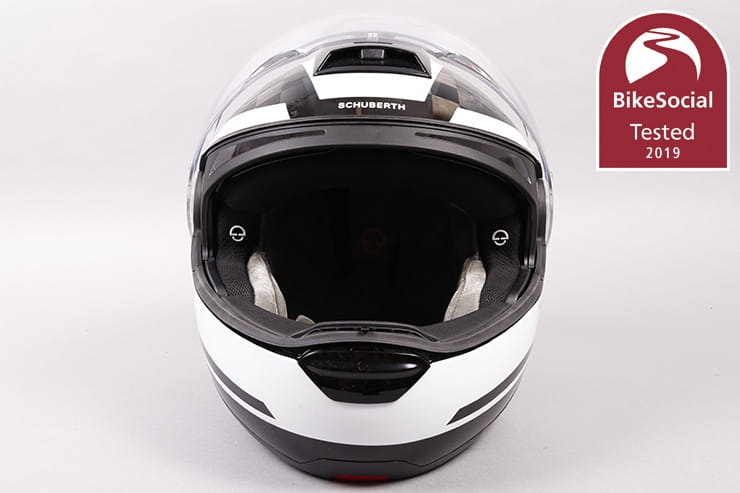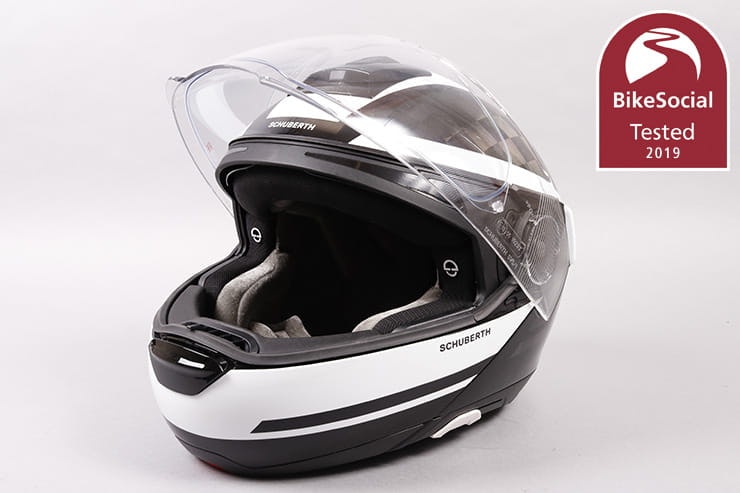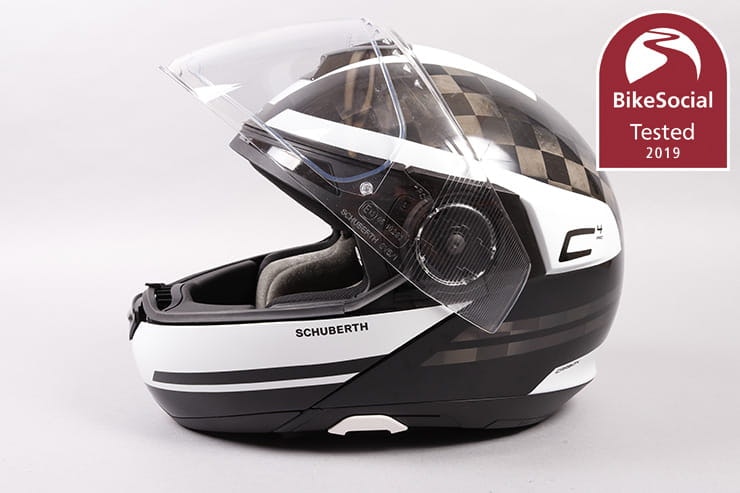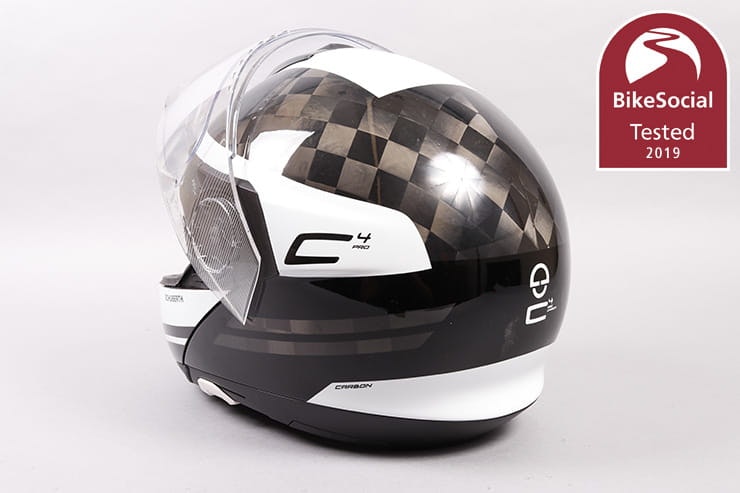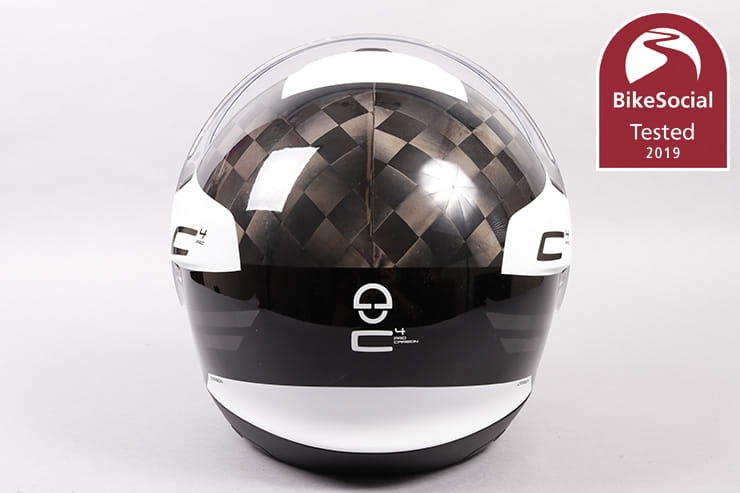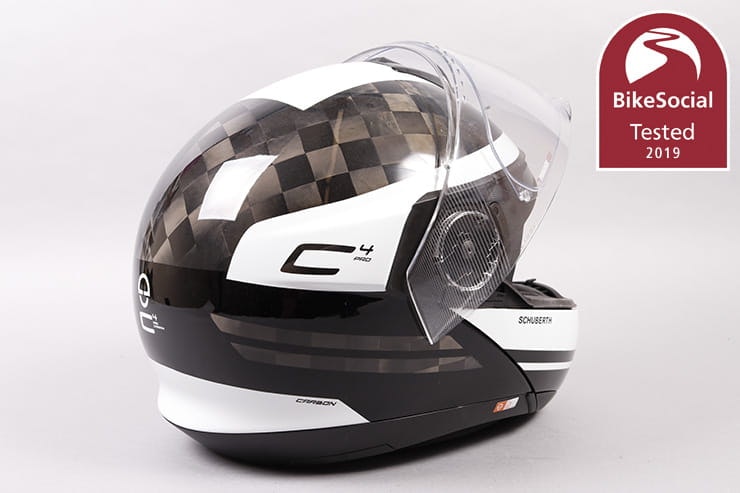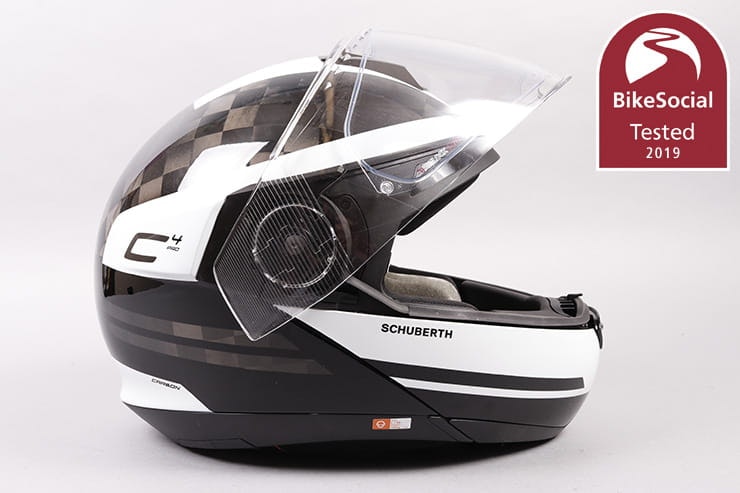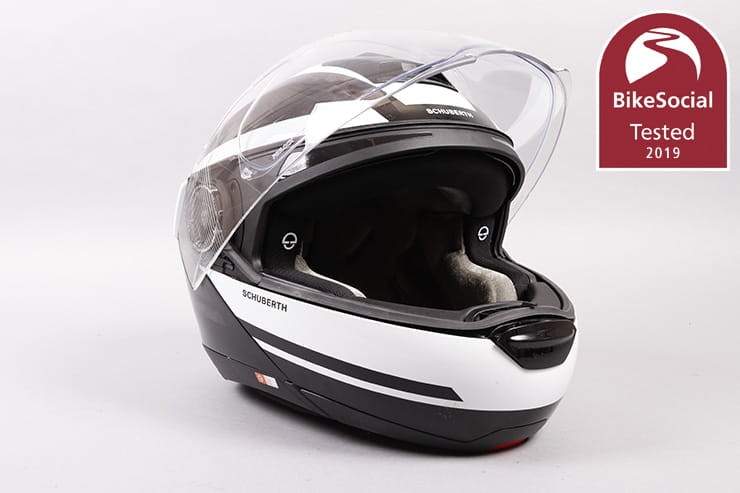Tested: Schuberth C4 Pro Carbon flip-front helmet review
By John Milbank
Consumer Editor of Bennetts BikeSocial
27.11.2019
Date reviewed: September 2019 | Tested by: John Milbank | Price: £699.99 | bikerheadz.co.uk
The new Schuberth C4 Pro is an evolution of the previous C4 model, with the Carbon model on review here being the top-of the range. Both will be in stores for some time alongside each-other, but the Pro is intended as a replacement.
There’s also a ‘Basic’ model, which is the same as the new Pro, but with a limited colour range of matt black or gloss white only, no intercom electronics pre-fitted and a lower-spec Pinlock anti-fog insert.
I’ve been using a Schuberth C4 Pro Carbon on a variety of bikes in all weathers for over 1,000 miles to find out if it’s the best flip-front motorcycle helmet…
Outer shell
The Schuberth C4 Pro Carbon has a very distinctive large checker-board style carbon-fibre weave. Revealed through the excellently-applied and well finished graphics, it looks great, only the seam running down the back letting it down a little – some graphics could have hidden this nicely.
It’s worth pointing out that this is the most expensive C4 Pro on the market; if you’re not worried about having a carbon-fibre shell, the plain C4 Pro costs £529.99, while graphics are £599.99, putting it at the same price as the Shoei Neotec II. The C4 Basic comes in at just £429.99, though you can only get that in matt black or gloss white.
Like the C4 before it, the new Pro model uses just two different shells across its range of sizes – other premium lids tend to have at least three. What this means is that if you take an XL, the outer shell will be the same as that used on the XXXL, or if you have an XS it’ll be the same external size as an L. Does it matter? Only if you think the helmet looks big when you’re wearing it.
The standard C4 Pro has a tough multi-fibre composite shell – both this and the carbon-fibre feel rigid, but like other flip-fronts, the chin-bar is plastic. Homologated only as a full-face lid, it’s technically illegal to ride with the C4 Pro open. When opened with the easy-to-operate button, the chin section stays up okay, but at low speed (so without the wind dragging it back), if you hit a bump it’s possible to get the front to drop down, where it sometimes stops just in front of your eyes. If you are riding with it open, take care.
Intercom
The C4 Pro and C4 Pro Carbon both come with an antenna, speakers and microphone ready fitted for a £250 Sena-made intercom module. The microphone in the previous C4 was hidden in the top of the visor aperture, but for increased clarity it now pokes just out of the side of the left cheek pad.
Fitting the intercom is easy – just plug the battery and control module in, then it’s ready to use. The buttons can be a little fiddly to access so you might want to consider the £47.80 SC3 or the £86.10 handlebar remote, but these comms are compact system that leaves nothing hanging off the side of your lid.
The battery on the previous C4 used to rattle about and disconnect, but on the C4 Pro there’s a rubbery pad that helps press down on it. And that battery has a great life – in my testing (playing streamed music at full volume), it lasted a class-leading 18 hours 50 minutes; outstanding.
The FM radio is the same as other intercoms… not much use if you’re travelling more than about 20 miles. Despite having RDS, stations tend to get lost after riding much further than an average commute.
The intercom range of the C4 Pro is listed as <1000m; in my testing of a non-carbon-fibre version it achieved 550m on open roads with line of sight, and 380m in town. In a housing estate, range dropped to 130m when a building got in the way. These are very typical results, but keep in mind that the carbon-fibre model has a range quoted as 200-500m, so if you rely on bike-to-bike communications, you’re best off sticking with the standard shell for maximum possible range.
The C4 Basic has none of the electronics ready-installed, so you save £100 (as well as limit your colour choice and have a slightly less-well performing Pinlock). Keeping in mind that you still need to add £250 for the intercom module, and you’re effectively paying £350 for the comms. The top-of-the-range Sena 30K is £289, so you might want to consider the Basic model and add your own intercom (though granted it’ll be stuck on the side); if like me you only use it for music and sat-nav directions, there are many much cheaper options, like the £119.99 Sena SF1 or the £129.99 Cardo Freecom 1+, reviewed here.
Weight
The C4 Pro Carbon weighs just 1491g in a medium, which is very impressive; the standard C4 Pro is 1695g. Having said that, while you can feel it in the hand, there’s little discernible difference when it’s on the head.
Ventilation
While there are no exhaust vents on the C4 Pro, the ventilation is impressive. The top vent is very easy to use, and it now has a mesh over the two intake holes to stop large bugs getting blasted inside. It’s also easy to remove the top and clean it out.
Cooling air is easy to control with a two position and off action, while the open or closed chin vent does a good jo of directing air up to your brow once you get up to speed.
Of course, if you’re riding behind a large screen the vents will struggle to get much air flowing, but you can take the chin skirt out for extra ventilation.
The visor can also be cracked just open for extra air if you need it.
Channels in the helmet help the air to move across the head, ending underneath the skirt.
Visor
The Schuberth C4 Pro has a big visor – horizontal view is fairly typical, and there’s no missing the prominent brow above your eyes (this isn’t a lid you’d want when crouched on a sportsbike), but looking down to a tank bag or your pockets is easy thanks to the deep aperture.
Thumb tabs on either side of the visor make it easy to pop open even if you’re sat at traffic lights with the clutch held in, and removing it is easy with a pair of levers releasing it quickly for cleaning.
The built-in sunshield drops down well without touching my nose. A small lever built into the slider on the bottom left of the shell allows you to restrict the drop by about 4mm, if you are finding it touching your nose.
I prefer to use a dark visor, but the sunshield works well and saves spending an extra £70.72. Replacement clear visors cost £55.57.
The standard visor is optically very clear with no distortion, though compared to other premium helmets it’s just the extra lower vision that stands out.
In the rain, there are no leaks when the visor is fully closed.
Unfortunately the visor has one major flaw – at speeds over about 65mph, it refuses to stay open. On the Kawasaki Versys 1000, even with the standard screen raised, I can’t ride with the sunshield down and the visor up for extra ventilation. While it could be argued that it’s safest to ride with the visor down, in hot climates it’s something I often do, and most other helmets can keep their visors in place.
If your bike has a large screen it’s likely not going to be a problem, but it is something I found irritating, especially when trying to adjust my glasses while riding.
Lining
The fully-removable lining can be washed to keep the C4 Pro fresh, and has been redesigned since the original C4 to be more plush and to seal more tightly around the neck.
I do have to say that this is the most complicated lining I’ve yet removed from a lid – the ties that are said to help reduce the risk of the helmet rotating over your head in a crash are a fiddle to get off the fastener straps, while the multiple poppers and hook and loop fasteners (one patch of which came unstuck) make it a time-consuming process.
Fastening
A micro-ratchet fastener makes it easy to do the strap up even with gloves on; once set, it’ll give a secure fit every time. Some prefer a double-D strap, but on a touring lid like this it makes sense.
The lining extends beneath the straps and fastens with hook and loop, but this adds an unnecessary hassle and makes taking the Schuberth off a little clumsy.
To keep the C4 Pro as quiet as possible, the opening is very tight, so it’s not possible to put the lid on without opening it first.
Fit
Fit is such a personal point that it’s difficult to judge a helmet based on someone else’s opinion. But the sizing on the Schuberth C4 Pro is unusual – I’m typically a medium but had to go up to a large with this lid.
As a rough guide, I’ve always found Arais to be comfortable, and Shoeis for at least the last ten years. Others are of course good too, but in Shark – for instance – only half of its range works for my head shape. The message is of course that it’s vital you try any lid on for yourself.
Here I find that the redesigned lining puts extra pressure on the back of my neck and around my lower jaw. There’s also a little pressure on my brow, so after several hours in the saddle I can find the C4 Pro gets a bit tiring.
As with any lid, when you’re in the shop, feel carefully for any pressure points that could become quite uncomfortable after an hour or so.
Noise
On a naked bike, the C4 Pro is outstandingly quite – to the point that, if you keep your speed under about 60mph, you could get away without earplugs.
However, most of the annoying noise we get when riding is down to the buffeting caused by the screen and fairing. On the Kawasaki Versys 1000 the Schuberth C4 Pro Carbon isn’t noticeably quieter than any other lid, and with the visor cracked open the booming rumble can get really distracting as speeds creep past 80mph.
This is a helmet that’s most likely to be worn by touring riders, so a screen is likely; if you notice buffeting noise in your current lid, this is unlikely to be much better.
For more information on why earplugs are vital with any helmet, and advice on which are the best, click here.
Conclusion
There’s a lot to like about the Schuberth C4 Pro Carbon, especially on a naked bike. It is expensive but this is the top-end model; drop right down to the C4 Basic and – as long as you’re content with the very limited colours – you’re getting the same fit and design without the parts for a dedicated intercom. It’s also worth noting that if you’re unfortunate enough to crash in your Schuberth, you can buy a new one (or an equivalent if that’s model’s no longer available) for a third of the price.
But the visor is a real disappointment to me – while it might not be an issue for those with very tall screens, or who will never want to ride at speed with the visor open and the sunshield down (and to be fair, it’s not something that’s technically a good idea), for me at least it just spoils what is otherwise a very good product.
Second opinion: Kane Dalton, commercial manager
“I’ve used the C4 Pro with a standard shell in matt black on sports bikes but find its design is most relevant to touring and commuting.
“I also had to upsize my shell size with the C4 Pro from a medium to large; my chin was pressed hard up against the chin guard and it was tight on my forehead.
“I’m impressed with the intercom – the smaller but more powerful speakers seem to give a clear improvement to the sound quality, with more definition and a higher treble range
(you can upgrade the original C4 with the new speaker and wiring loom). I find it annoying reaching up to the helmet to find the buttons so went for the £100 Schuberth handlebar remote.
“I find the ventilation adequate for a road-biased helmet, letting through enough air for comfort. Both the chin and top vent are really easy to use while wearing gloves but I do find I’m not sure if the chin vent is open or closed when I go by feel. I tend to take a glance in the mirror to confirm. If I’m cruising in town and need more ventilation I just pop the lid open.
“I have cut the tabs under the fastener shorter and got rid of the Velcro – the idea is good and may work for some but it’s not for me; I found the extra padding bulky, especially with the new bigger neck roll.
“As everyone has a different shape head it’s always best to try a helmet on to get the best fit for you. I find with some helmets I need to tweak or modify the fit slightly. There’s nothing worse than getting an ill-fitting helmet and having to ride for hours. I have not yet done any tours with the Pro but the first run was over 150 miles with various speeds and it was comfortable.
“For local riding with slower speeds I don’t wear earplugs; I have the music playing through the comms system so am not really aware of the wind noise most of the time. For motorway riding I use earplugs but thanks to the improved drivers in the speakers I can still hear the music.
“As I have been riding naked bikes I have not had any of the vibration or noise caused by turbulence behind a screen. It has been clear air with no resistance or high wind noise.
“I was never a fan of flip-front helmets, much like I was never a fan of heated grips. But now think all bikes should come with heated grips as standard and I’ve seen all the benefits of the flip front; asking for directions is easier and I don’t I get as much hassle at petrol stations with the lid open… it really is so versatile.”
